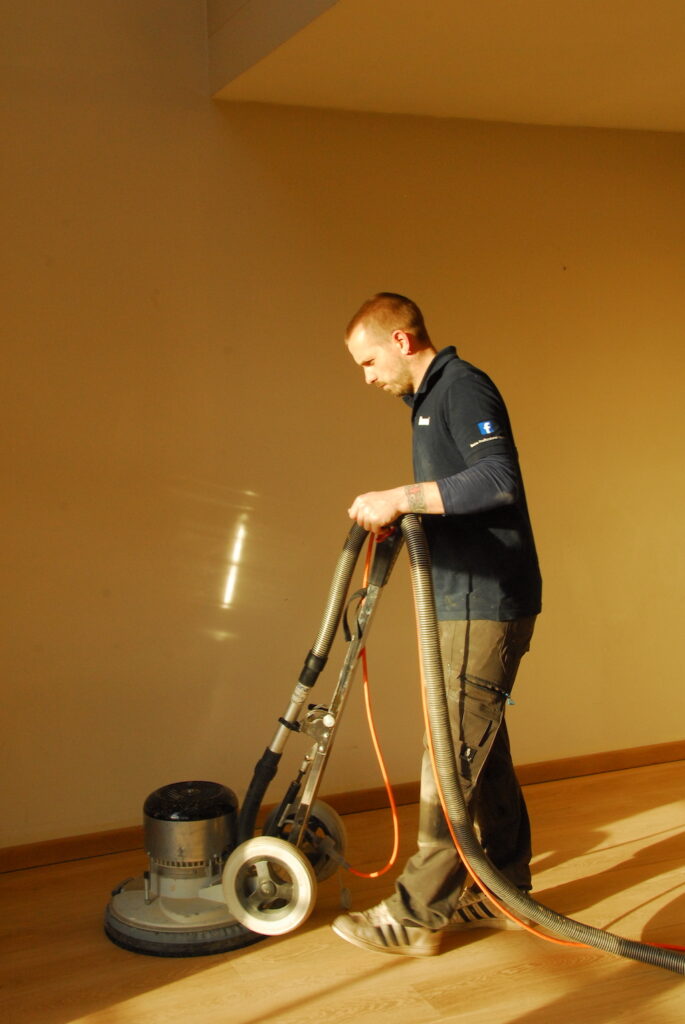Reviving your parquet floor, that’s something you can handle on your own, or so we thought for years. That was until we met the passionate Bona parquet expert, Michael Devriendt. His demonstration quickly changed our perspective. Sanding parquet floors is not DIY. It is a job for a true professional! Looking back, we can only feel delighted and grateful for this encounter that saved our solid, French oak parquet floor.
Text and pictures WOWwatchers.com

It all started with Michael arriving in a station wagon loaded with equipment. The unloading of machines and tools seemed never-ending. And here we were, thinking that renting a sanding machine would suffice.

By the way, Michael doesn’t work with an ordinary belt sander; he uses the Bona Flexisand. This rotary sanding machine has four rotating discs that can sand down to bare wood. Unlike a belt sander, which can sometimes veer in different directions, this sanding machine operates exceptionally stable. The rotating discs also follow the floor’s surface lines, resulting in an even sanding outcome.



Michael clearly has his technique: he moves in a straight line along the wood grain and then retraces his steps backward on the same path. Moreover, he sands in overlapping sections. Finished sanding two planks? With the next pass, he includes one of the previously sanded planks.
As for dampening, it’s better not to attempt it yourself,” says Bona specialist Michael. “The slightest mistake in this regard can result in color discrepancies in the finish. If you use less water in certain areas or miss a spot, the color in that area will be less intense.”



But how do you know which grit to use for sanding? Should you dampen the floor first to achieve the desired color? Which oil should you choose? These are questions the expert can answer, but ones that a novice DIY enthusiast can easily get wrong. “As for dampening, it’s better not to attempt it yourself,” says Michael. “The slightest mistake in this regard can result in color discrepancies in the finish. If you use less water in certain areas or miss a spot, the color in that area will be less intense.”
Many well-intentioned individuals pick up a 220-grit sandpaper, sand a plank, and then oil it with the same oil the expert used, yet there’s still a color difference. And they wonder why.

Oil or Varnish?
“Both oil and varnish have their pros and cons,” explains Michael. “The biggest advantage of varnish is that by applying it, you completely seal the floor, making it highly stain-resistant and easy to maintain. Those are two significant advantages. The downside is that in case of a scratch (from, say, moving a chair or a sofa), there’s not much you can do. You can attempt localized touch-ups, but sanding and refinishing the plank with the scratch is risky because the transition will likely remain visible. Otherwise, varnish has few disadvantages. You apply three layers of varnish, fully sealing the floor, allowing you to drop a glass of wine or a nut without worry. With oil, you know that letting it soak in could lead to stains. The advantage of oil is that you can restore it locally. You can sand down a plank and add color, but it’s best to leave this to the professional. If you want to sand a plank, follow the same method your flooring expert used for the entire floor. This means finishing with the same grit sandpaper that the expert concluded with. Many well-intentioned individuals pick up a 220-grit sandpaper, sand a plank, and then oil it with the same oil the expert used, yet there’s still a color difference. And they wonder why. When sanding parquet, it’s best not to go finer than grit 80 or 100. If you want to sand the parquet even finer, it’s advisable to use water to open up all the pores. Opting for oil has the advantage that within five years, if it gets dirty, you can choose deep cleaning. We add a maintenance layer, and you’re good for another five to ten years. With varnish, maintenance is more drastic. With varnish, after five or ten years – depending on wear – if you haven’t used polish, you’ll need to sand it completely. This means using fine sandpaper to dull the floor, then applying a new layer of varnish, but you’ll need to clear the room. With oil, you might decide to leave heavy furniture in place and work around it. That’s not always ideal, but necessity dictates. With varnish, that’s not an option.

“I’ve personally used wax on the floor of my office,” says Bona parquet expert, Michael. “But I’m not a big fan of wax because it’s not very healthy. It contains a lot of turpentine. For my bedroom and bathroom, I chose varnish. My floor extends all the way from the bedroom to the bathroom, and with little kids, varnish is practical for quick cleaning. But the parquet in my living room I oiled because, as a parquet expert, that’s what I find most beautiful.”



